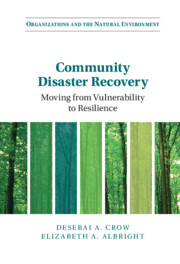Book contents
- Community Disaster Recovery
- Organizations and the Natural Environment
- Community Disaster Recovery
- Copyright page
- Dedication
- Contents
- Figures
- Tables
- About the Authors
- Foreword
- Preface
- Acknowledgments
- Abbreviations
- Part I Introduction
- 1 Introduction to Disasters, Change, and Community-Level Resilience
- 2 Colorado’s 2013 Floods
- Part II Damage and Resources
- Part II Review
- Part III Individual Beliefs
- Part III Review
- Part IV Individual and Group Engagement
- Part IV Review
- Part V Connections, Conclusions, and Recommendations
- Book part
- Bibliography
- Index
1 - Introduction to Disasters, Change, and Community-Level Resilience
from Part I - Introduction
Published online by Cambridge University Press: 08 October 2021
- Community Disaster Recovery
- Organizations and the Natural Environment
- Community Disaster Recovery
- Copyright page
- Dedication
- Contents
- Figures
- Tables
- About the Authors
- Foreword
- Preface
- Acknowledgments
- Abbreviations
- Part I Introduction
- 1 Introduction to Disasters, Change, and Community-Level Resilience
- 2 Colorado’s 2013 Floods
- Part II Damage and Resources
- Part II Review
- Part III Individual Beliefs
- Part III Review
- Part IV Individual and Group Engagement
- Part IV Review
- Part V Connections, Conclusions, and Recommendations
- Book part
- Bibliography
- Index
Summary
This opening chapter to Community Disaster Recovery: Moving from Vulnerability to Resilience introduces readers to the increasing importance of disasters in the context of climate change. The chapter draws upon examples of various disasters to illustrate the topical importance and to motivate the specific analyses to follow. The discussion articulates the necessity of governments at all scales to cope with preparing for extreme events and provides an overview of what governments go through after a disaster. In particular, whether governments learn lessons in the aftermath of disaster can determine how they choose to rebuild. These decisions can lead to greater resilience for communities, but prior studies have rarely found this observed outcome. This chapter ends by motivating the question that structures the rest of the book – what factors lead a community to learn, make changes, and move towards a more resilient state after it is struck by a disaster?
- Type
- Chapter
- Information
- Community Disaster RecoveryMoving from Vulnerability to Resilience, pp. 7 - 26Publisher: Cambridge University PressPrint publication year: 2021

